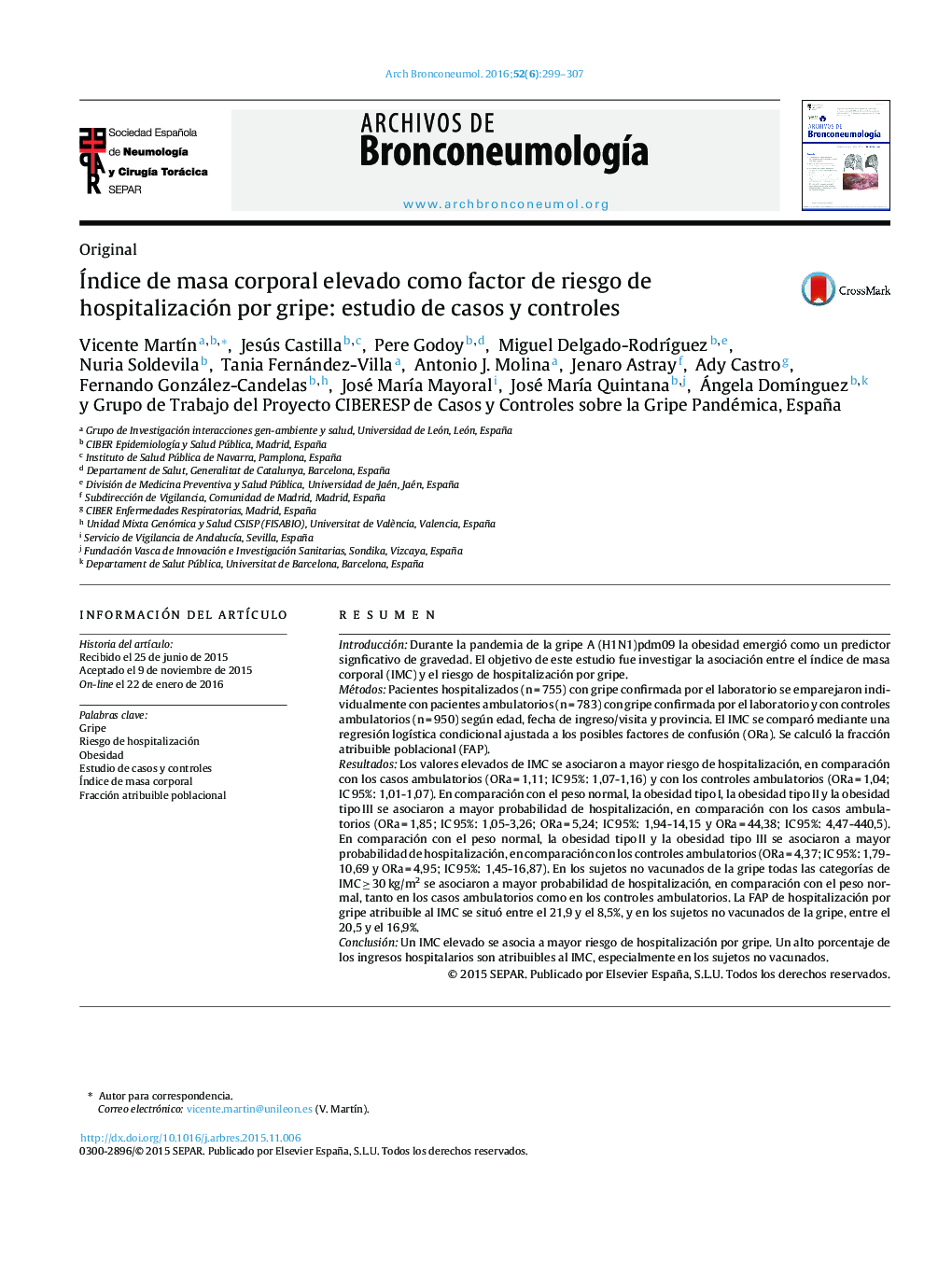| کد مقاله | کد نشریه | سال انتشار | مقاله انگلیسی | نسخه تمام متن |
|---|---|---|---|---|
| 4202821 | 1279473 | 2016 | 9 صفحه PDF | دانلود رایگان |
ResumenIntroducciónDurante la pandemia de la gripe A (H1N1)pdm09 la obesidad emergió como un predictor signficativo de gravedad. El objetivo de este estudio fue investigar la asociación entre el índice de masa corporal (IMC) y el riesgo de hospitalización por gripe.MétodosPacientes hospitalizados (n = 755) con gripe confirmada por el laboratorio se emparejaron individualmente con pacientes ambulatorios (n = 783) con gripe confirmada por el laboratorio y con controles ambulatorios (n = 950) según edad, fecha de ingreso/visita y provincia. El IMC se comparó mediante una regresión logística condicional ajustada a los posibles factores de confusión (ORa). Se calculó la fracción atribuible poblacional (FAP).ResultadosLos valores elevados de IMC se asociaron a mayor riesgo de hospitalización, en comparación con los casos ambulatorios (ORa = 1,11; IC 95%: 1,07-1,16) y con los controles ambulatorios (ORa = 1,04; IC 95%: 1,01-1,07). En comparación con el peso normal, la obesidad tipo I, la obesidad tipo II y la obesidad tipo III se asociaron a mayor probabilidad de hospitalización, en comparación con los casos ambulatorios (ORa = 1,85; IC 95%: 1,05-3,26; ORa = 5,24; IC 95%: 1,94-14,15 y ORa = 44,38; IC 95%: 4,47-440,5). En comparación con el peso normal, la obesidad tipo II y la obesidad tipo III se asociaron a mayor probabilidad de hospitalización, en comparación con los controles ambulatorios (ORa = 4,37; IC 95%: 1,79-10,69 y ORa = 4,95; IC 95%: 1,45-16,87). En los sujetos no vacunados de la gripe todas las categorías de IMC ≥ 30 kg/m2 se asociaron a mayor probabilidad de hospitalización, en comparación con el peso normal, tanto en los casos ambulatorios como en los controles ambulatorios. La FAP de hospitalización por gripe atribuible al IMC se situó entre el 21,9 y el 8,5%, y en los sujetos no vacunados de la gripe, entre el 20,5 y el 16,9%.ConclusiónUn IMC elevado se asocia a mayor riesgo de hospitalización por gripe. Un alto porcentaje de los ingresos hospitalarios son atribuibles al IMC, especialmente en los sujetos no vacunados.
IntroductionObesity has emerged as a significant independent predictor of severity in pandemic influenza A (H1N1)pdm09. The aim of this study was to investigate the association between body mass index (BMI) and the risk of hospitalization due to influenza.MethodsHospitalized patients (n = 755) with laboratory-confirmed influenza were individually matched by age, admission/visit date, and province with an outpatient (n = 783) with laboratory-confirmed influenza and an outpatient control (n = 950). We compared the BMI using conditional logistic regression adjusted for potential confounding factors (aOR). The population attributable fraction (PAF) was calculated.ResultsA higher BMI was associated with an increased risk of hospitalization compared to both outpatient cases (aOR = 1.11; 95% CI: 1.07-1.16) and outpatient controls (aOR = 1.04; 95% CI: 1.01-1.07). Compared with normal weight, obesity type I, obesity type II and obesity type III was associated with a greater likelihood of hospitalization compared with outpatient cases (aOR = 1.85, 95% CI: 1.05-3.26; aOR = 5.24, 95% CI: 1.94-14.15 and aOR = 44.38, 95% CI: 4.47-440.5). Compared with normal weight, obesity type II and obesity type III was associated with a greater likelihood of hospitalization compared with outpatient controls (aOR = 4.37, 95% CI: 1.79-10.69 and aOR = 4.95, 95% CI: 1.45-16.87). In persons without influenza vaccination, all categories of BMI ≥ 30 kg/m2 were associated with a greater likelihood of hospitalization compared with normal weight in both outpatient cases and outpatient controls. The PAF of hospitalization by influenza due to BMI ranged from 21.9% to 8.5%; in the case of unvaccinated against influenza between 20.5% to 16.9%.ConclusionA high BMI is associated with an increased risk of hospitalization due to influenza. High percentage of hospital admissions are attributable to their BMI, especially in non vaccinated.
Journal: Archivos de Bronconeumología - Volume 52, Issue 6, June 2016, Pages 299–307
